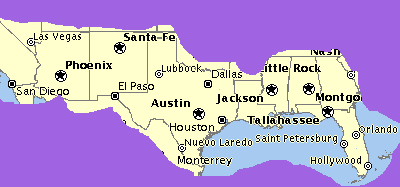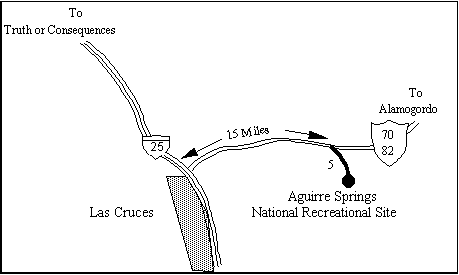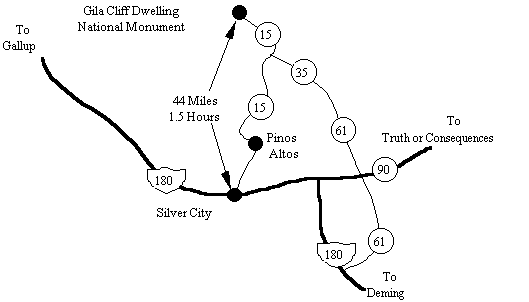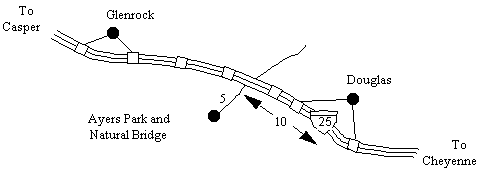Chapter 3 - The Sunbelt States: Free,
Cheap, and Impossible
Although we only hit 13 states (AL, FL, MS, LA, TX, NM, CO, WY, SD, ID, UT, NV, CA) during our trip, most are the states of the sunbelt so are probably the more important ones for a new traveler. I like sunshine and assume others do also. This chapter tells some of the differences between these states relative to where you can park free, how they appear to feel about vagabonds, what time of year to visit (and not to visit) each of them, and I've also included some maps to interesting and little-advertised free (or real cheap) things to see.
In the title to this chapter, I promised to talk about free, cheap, and impossible -- I'll talk about impossible first. Impossible is Florida and California. If you're trying to avoid campgrounds, these are the two states where it gets really difficult. They get alot of campers in these two states and I guess if everyone tried to camp free on the side of the road, things could get pretty crowded. Floridians go a little overboard, however, on trying to charge for everything. On the west coast of Florida, it's almost impossible to even stop and visit the ocean. We drove alot of miles up Highway 27 along the coast looking for anyplace to park and go walk in the sand. It seemed like every beach access road was private for those who lived in the area. We finally had to stop in the parking lot of a motel and walk through the motel to get to the beach. It's not quite that bad on the east coast, but alot of places there will charge a couple of dollars to just get onto the beach. I grew up in Florida and really hate to see it get so commercial. In my teenage years, I really used to enjoy wandering up and down the coasts and going from beach to beach. The only thing that I had to pay for then was gas and food. Nowadays, I probably wouldn't be able to afford to go wandering.
California is not quite as bad as Florida, since you can still get to the beaches. Some of them cost $1-$3 to get to, but at least you can get to them. Forget camping free though -- it is exactly like Florida. They have plenty of campgrounds and expect you to use them. In both states, it's possible to find parking in out-of-the-way shopping center parking lots or in apartment house parking areas, but keep your eyes open for "no camping" signs. We found that the farther you get from the beach, the better off you are. People who live close to the beach appear to be real paranoid about transients. I think they are afraid that if they let one person camp, then a whole city of transients will emerge shortly thereafter -- they may be right. At any rate, things get better when you get a few miles away from the beach. Then, if you can find a parking lot that's off the beaten track, you are less likely to be ejected by police. At one point in San Diego, we stopped in a lot at a large mall and settled in for the night. At about 11:00, the police came knocking at our door to tell us this was against the law. After some friendly chat, however, they led us to a different parking lot (at a bank) that was off the main street and told us we could stay there with no problems. It seemed that we were ok as long as we weren't too obvious to the local townspeople.
Now we move from impossible to cheap. Actually, cheap is a relative term -- we were on such a tight budget that to pay anything to camp was bothersome. At some point on the California coast just north of Los Angeles, we came to a place where campers were lined up along the highway for miles. We found out that the charge was only $4 per night -- not bad compared to most campgrounds -- but still more than we wanted to pay. A really nice deal for those who were willing to pay a little, though. The highway ran right along the beach and the view was terrific. That's one fact about California beaches -- the view is alway pretty fantastic. Just fine as long as you don't want to swim. Most of the beaches look real good from a distance, but upon closer inspection are found to either have oil/tar in them or large amounts of seaweed that wraps around you as soon as you enter the water. On top of that, the water in the Pacific Ocean seems to stay cold year round. If you want a view, go to California. If you want to swim, go to Florida.
Speaking of cheap, there is another significant benefit to Florida beaches over most others in the country. That is that salt-water fishing in Florida doesn't require a fishing license. Update: That was true in 1990, but no longer is. They decided to start licensing salt-water fishing also. The only free way now is to wait until you're over 65 or fish with a cane pole. This may not seem very important, since fishing licenses don't cost much. This is true if you live in one state and only buy one license, but if you're moving from state to state and buying a 3 to 5-day license in each state for anywhere from $4 to $18, it begins to become more important. If you fish without a license, you're taking a chance on paying a fine of several hundred dollars. Anyway, it's real relaxing to be able to fish anywhere along the Florida coast without having to either pay for a license or worry about the fine -- sure do hope they don't change that. I have heard murmurs about a national license for those who travel -- that would be real nice.
The place that immediately pops to mind when I think of great cheap experiences is Carlsbad Caverns, New Mexico. The $2 each we spent there was the most enjoyment we've had at that price ever. The caverns are spooky, big, impressive, dark, beautiful, deep, educational, ... just about the best $4 we ever spent.
Now let's talk about what's free -- the most interesting area as far as I'm concerned. When I think of great free stuff, I think of New Mexico. Before we took this trip, I had always thought of New Mexico as the square state that you had to go through to get from Texas to Arizona. By slowing down and looking around a little, plus having friends in Las Cruces who showed us some of the sights, we found New Mexico to be just about the most interesting and enjoyable state we went through. One of the first surprises that we had was when we stopped in one of their roadside parks. Not only did we not see any "Don't camp here" signs as we had in several other states, but we found to our amazement that they had water and electricity at the picnic tables. We later found out that they have many free campgrounds that you can stay in for 30 days at a time.
One of the free campgrounds that we stopped at was Aguirre Springs, which is in the mountains north of Las Cruces. Take Highway 70 North for about 15 miles until you see the sign. Then follow the little winding road for about 5 miles (may be too winding for large motorhomes). The campground has picnic tables, water, fireplaces for cooking, and great scenery. We went there with our Las Cruces friends, cooked hamburgers and hot dogs to go with the beans and potato salad, then sat around the campfire and told ghost stories. Great fun at a real nice campground.
You're Visitor #
 | ||||
Retire and Travel For $1000 a Month

Gila River Campground
Probably the most beautiful free campground that we found in our travels was Ayers Natural Bridge near the town of Douglas, Wyoming. Look at my crude little map to see how to get to it. We stumbled onto it by reading a brochure on the Oregon Trail. It seems that this was "a favorite stop for the pioneers on their way West." Now it consists of a small, rustic camp with about six parking spots nestled back in the woods next to a small creek. There is a large hole in a rocky butte that the creek flows through, hence the name Natural Bridge. The camp is run by an older couple and has no amenities like water or electric hookups. It's real quiet -- when we were there, everyone disappeared into their campers/tents at about 9 P.M. You almost feel like there is a curfew. There are alot of interesting hiking trails nearby, you can wade or fish in the creek (La Prele River), or (as I did) simply sit and watch the creek go by.

Aguirre Springs Campground
We also stayed several days at a free campground on the East fork of the Gila River near the Gila Cliff Dwellings. It also was rustic without water or electricity, but was really scenic. We were right on the bank of the river with a very high cliff right across the river. Many, many places to hike, climb, swim, fish, relax, and people-watch. When we got there, I had a 5-day fishing license ($15), so spent alot of time hiking up and down the river dragging my fishing pole. The water was so clear, you could see the trout in the stream, but they wouldn't bite anything I had. It was still enjoyable, even though I never caught a fish. We stayed there over Memorial Day weekend and, although there were plenty of people to watch, it really wasn't as crowded as you would expect on a holiday. Certainly not as crowded as parks in California on holidays.

Natural Bridge Campground
These are just a few examples of the kind of camping you can do by looking around a little. Most highway maps show you where the campgrounds are, but you have to go find them to see what they have to offer. We found those described above by simply looking on a roadmap, but didn't know what to expect until we got to them. If you want to spend a few dollars, there are also highly detailed books of campgrounds which tell what facilities they have, if they cost anything, etc.
Aside from campgrounds, we found a number of other free things to do in our travels around the country. Below, I have listed a few of these and rated them with up to four stars relative to their interest and entertainment value:
As with campgrounds, there are also books you can buy that go into great detail about things to see around the country. That is not really the intent of this book, since others are way ahead of me on this type of research, so let's go on to something else. In the intro to this chapter, I promised to tell the good and not-so-good times to visit various states. Although much of this is pretty obvious if you merely watch the weather reports, here is a summary:

My First Book
Nothing in this site is copyrighted -- I'd be honored if you'd reuse anything you find here for your website
 | ||||||
